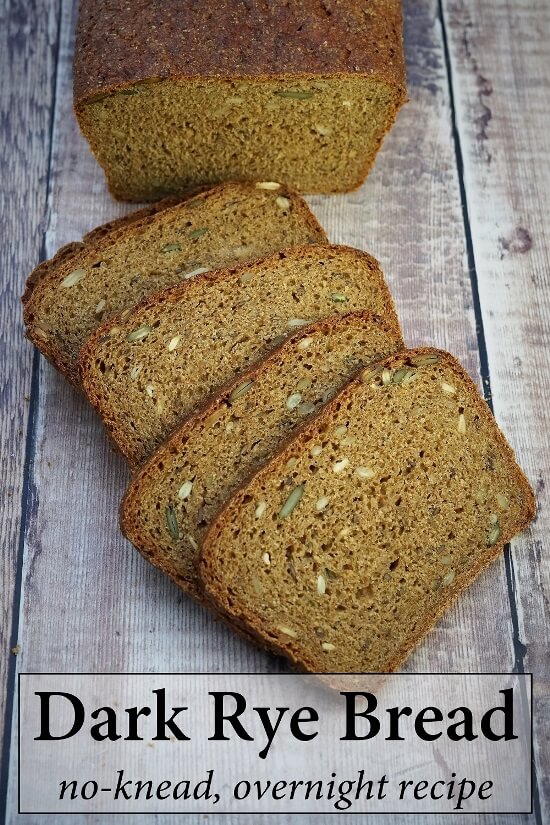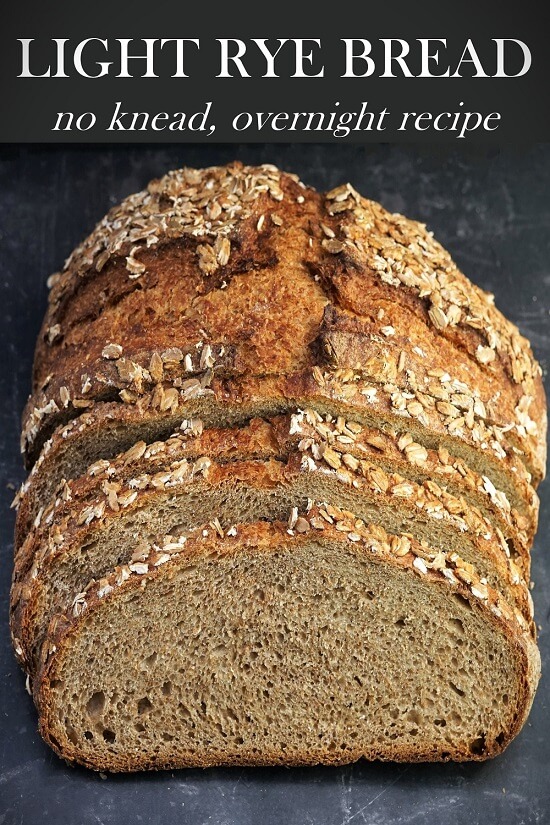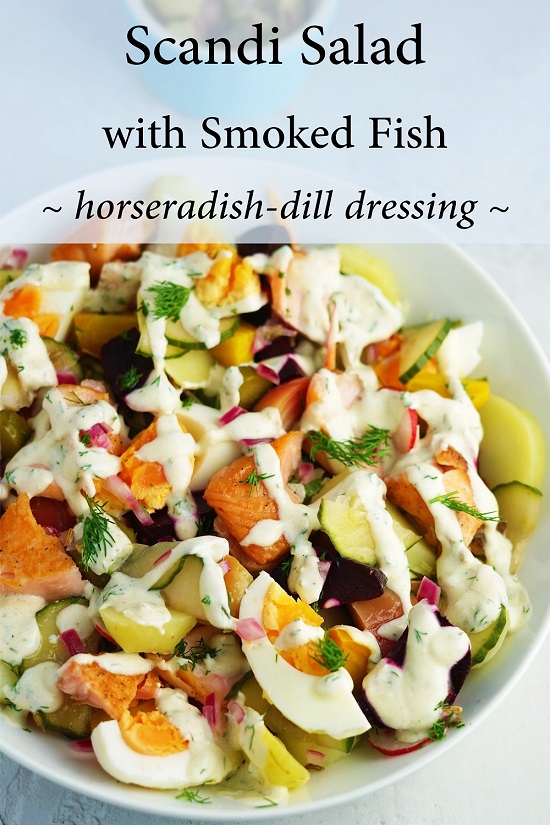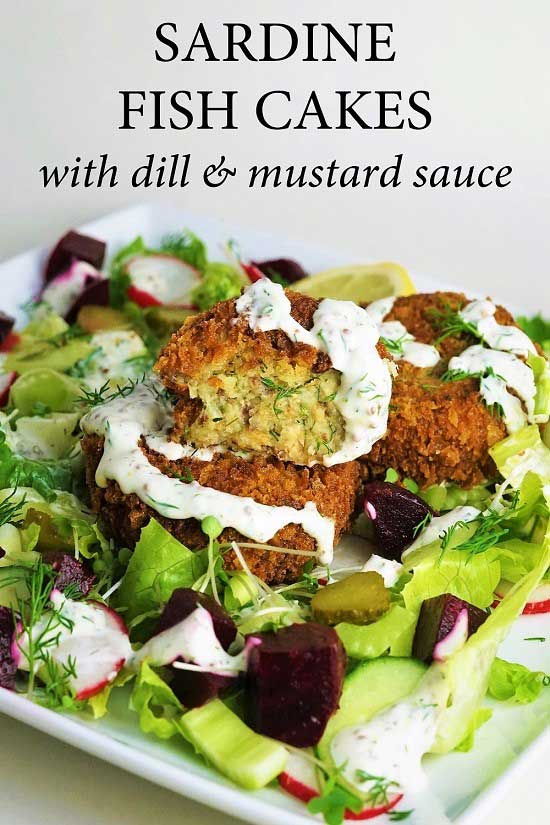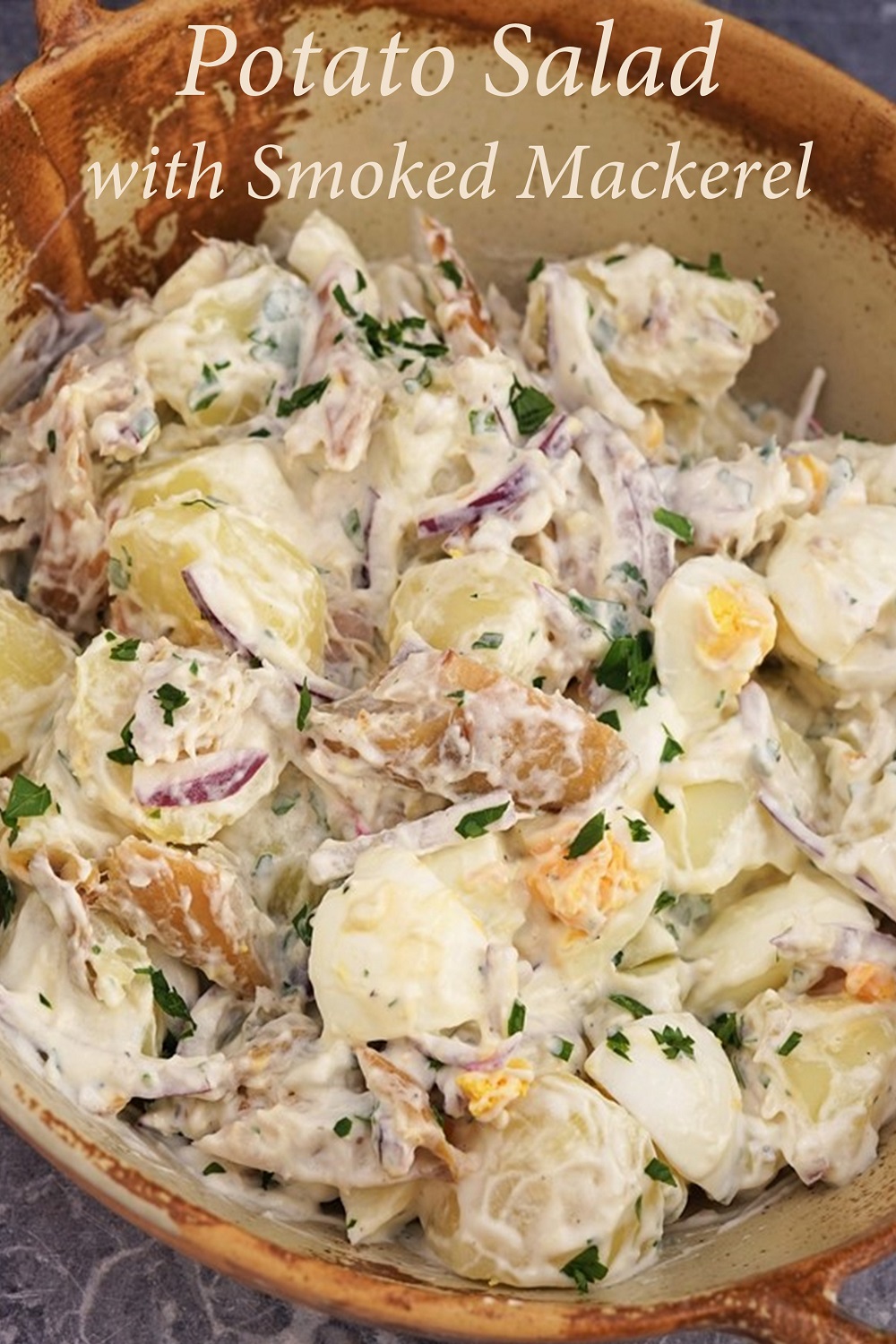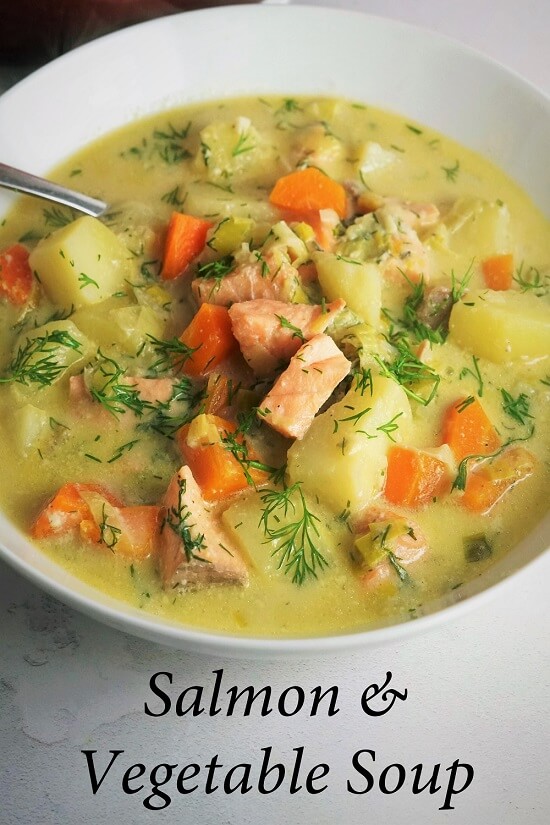Smørrebrød: Danish-style open sandwiches
Smørrebrød are Danish-style open sandwiches so generously heaped with tempting toppings that you have to be eat them with knife and fork. In this post you’ll learn the steps to making delicious smørrebrød, which bread to use (and how to bake your own), ideas for traditional toppings, plus SIX of my favourite simple open sandwiches.
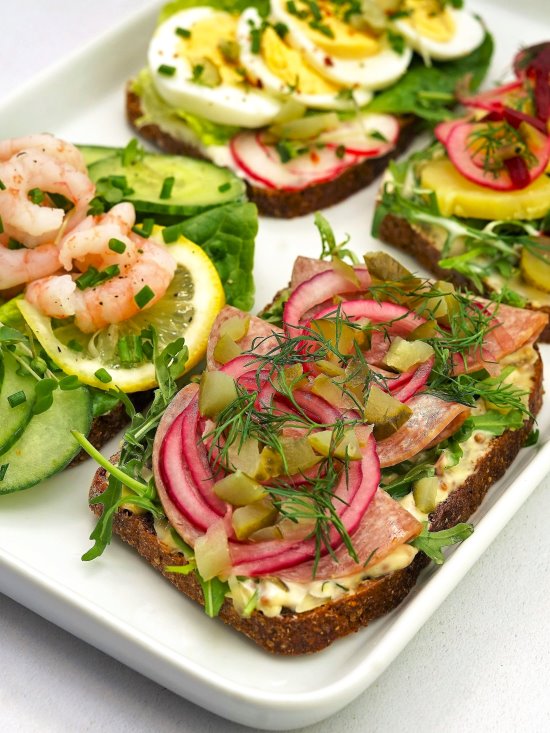
WHAT IS Smørrebrød?
Smørrebrød, apparently pronounced smuhrbroht, simply means buttered bread. Smørre is buttered and brød is bread. However, as you’d expect from what is considered the national dish of Denmark, there’s usually rather more to it than that. Fish, meats, eggs, and dairy are paired with various vegetables and garnishes to create attractive, substantial open-faced sandwiches.
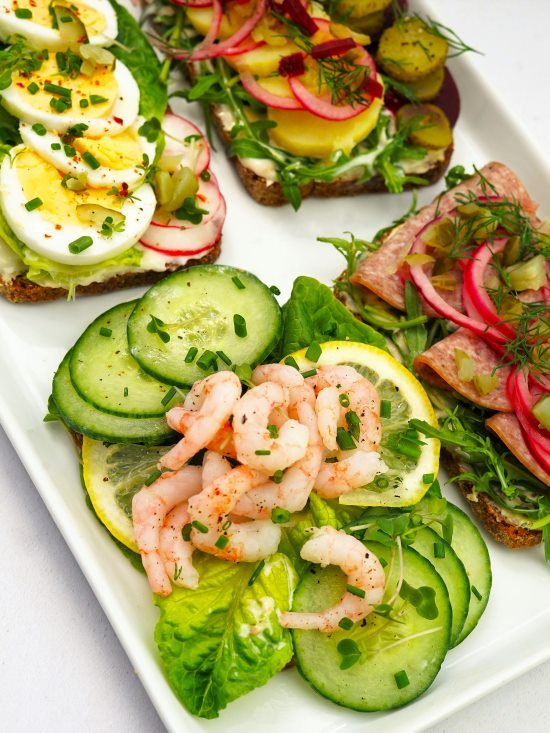
Of course, bread with various toppings is seen in other countries too. But Denmark seems to have made it their own, including restaurants like PALÆGADE (its name refers to the Danish word for the toppings) specialising in classic and contemporary smørrebrød.
ORIGINS
It’s been suggested that the modern love for smørrebrød came about following the movement of working people from the land and into factories in the nineteenth century. With the midday meal now being eaten away from home, it’s said that leftovers were taken to work and eaten on bread. But I don’t think this really explains smørrebrød’s association with Denmark. After all the same movement of people occurred all over Europe (see the origins of Staffordshire Oatcakes for example).
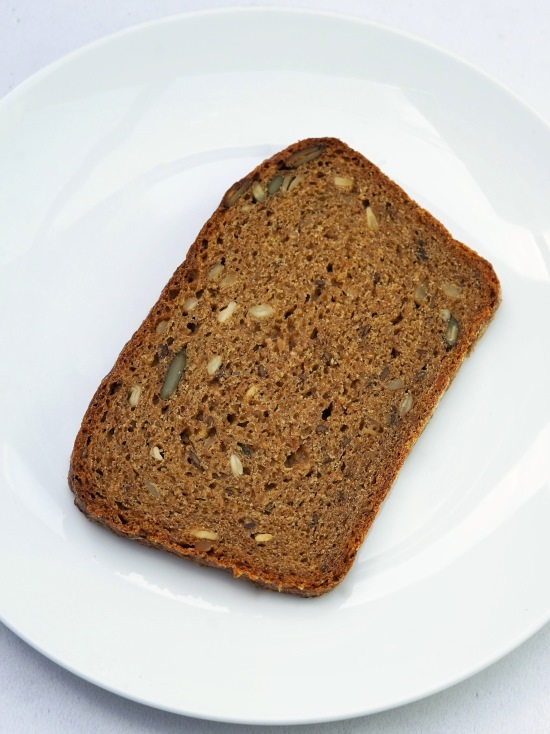
More likely, it seems to me, is that smørrebrød is just a regional variation of the trencher. This was the Medieval slice of bread from which a meal was eaten prior to the widespread use of plates.
But whatever its origins, I think that smørrebrød is something that more of us in Britain should be tucking into. With many wanting to reduce our carb intake (including of nutritionally poor, ultra-processed and refined carbs), the thinly cut, good quality rye bread traditionally used can only be a good thing. Add to that fresh vegetables, raw and cooked, plus moderate amounts of protein and fats, and you’ve a meal that will keep you satisfied for hours.
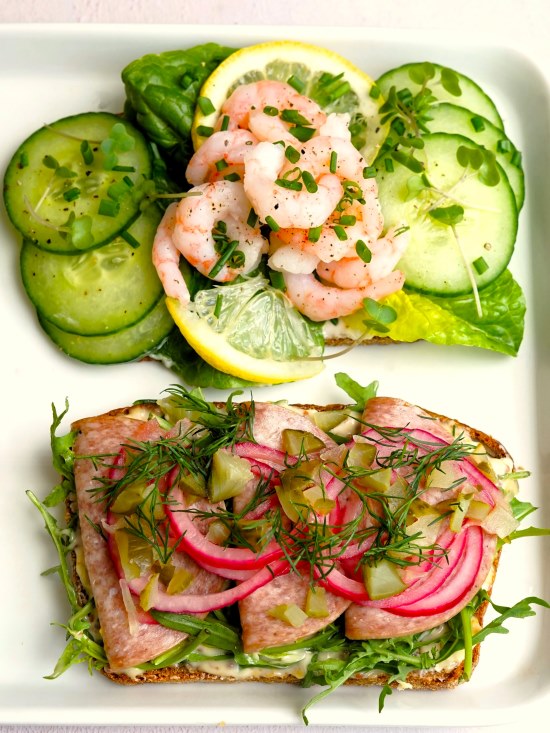
HOW TO MAKE Smørrebrød
There are certain ‘rules’ about making and eating smørrebrød. For example, it’s said you should never mix proteins on the same slice. There’s also a traditional order for eating several e.g. fish should come before meat which is followed by cheese. However, although I’ve been inspired by the Danish version, I just want to make open sandwiches that taste good as well as attractive to the eye.
But whether you’re going traditional or bespoke, the foundations of your sandwich, i.e. bread and butter, have to be right.
THE BREAD
The traditional base for smørrebrød is dark rye bread. In Danish, this is called rugbrød. Full of flavour, it’s also firm textured. This means it’s less likely to disintegrate when you butter it AND it can support plenty of those all-important toppings.
Obviously, you could buy some good quality rye, but I prefer to bake my own. My Dark Rye Bread recipe is surprisingly easy with an overnight, no-knead method.
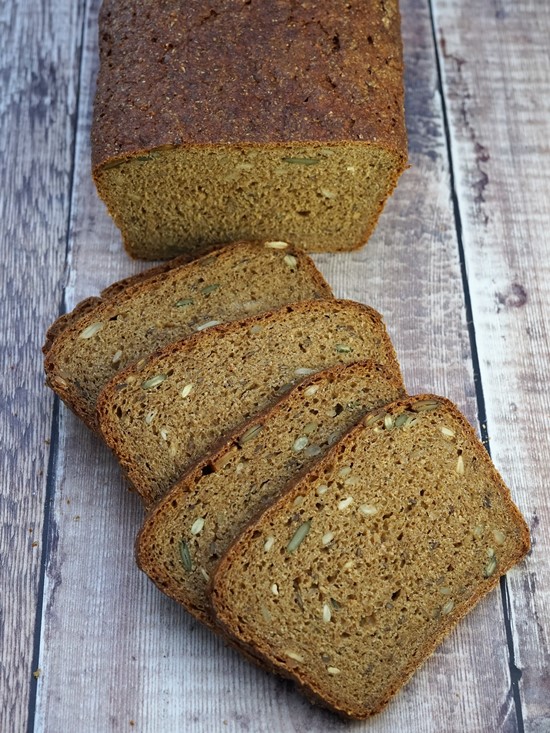
Ideally, you should start the bread at least two days before you plan to eat it. This is to allow for a long fermentation and also a period of maturing the baked loaf. If that sounds like a lot of trouble, it honestly isn’t. The hands-on time is minimal and you’ll be rewarded by great tasting, healthy rye bread. It freezes really well too. I slice the whole loaf before freezing. This allows me to take out only what I need with no waste.
If you don’t have firm dark rye bread you could buy or make sourdough or try my Light Rye Bread. However, being less firm, you might want to lightly toast them first. Be sure to cool before buttering though.
BUTTER
The traditional butter isn’t just there because it’s delicious. A thick layer also stops any juices from the topping seeping into the bread and making it soggy.
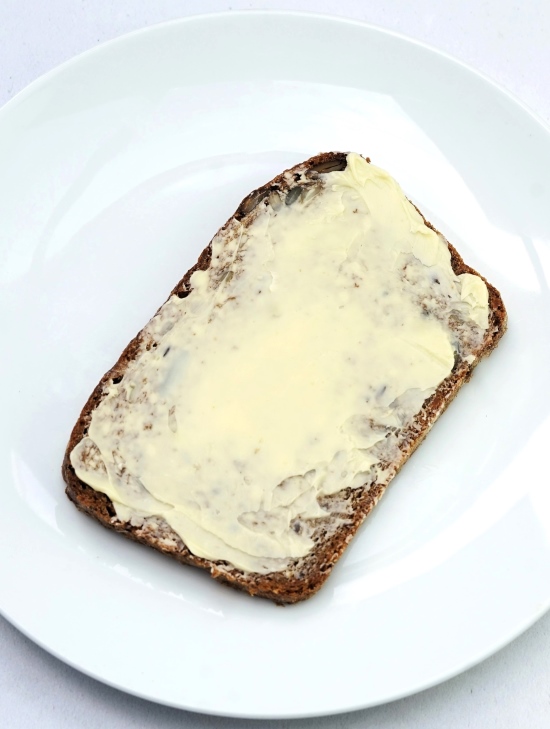
To give you an idea of just how much butter you should spread on your bread, the Danes have a word for it: tandsmør. This translates as ‘tooth butter’ and means that, after you’ve taken a bite, you should see teeth marks in the butter. Which is pretty much my standard depth of butter anyway 😁.
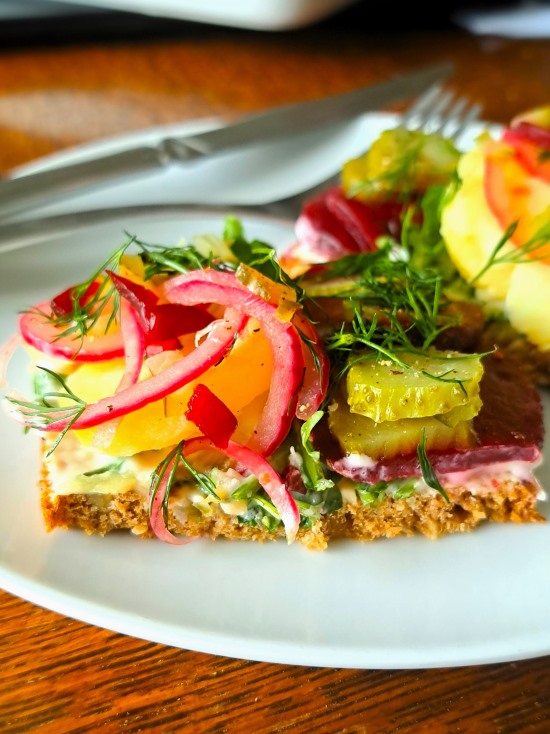
And it certainly does work. For the different open sandwiches I photographed for this post, it was well over an hour between making them, doing the photoshoot and my partner and I eating them. At the end, all the bread was still good and firm with no signs of sogginess.
TOPPINGS
Now we have our buttered bread it’s time for the toppings or pålæg. A lovely retro book I own, Scandinavian Cooking (1973), suggests around 20 different toppings and says, ‘an array should delight the eye as well as whet the appetite’.

The ideas it gives are probably quite useful if you’re after traditional rather than contemporary or trendy open sandwiches. They also highlight the basic structure of a good open sandwich. After the butter, you should include vegetables and/or fruit (e.g. cucumber, potato, tomato, apple) and a protein (fish, meat, eggs, cheese). As you can see from the image above, you finish off with a garnish.
Here’s some they include.
FISH
Top the buttered bread with thinly sliced cucumber, tomato or cold potato plus:
- marinated herring in cream sauce or freshly fried herring
- smoked eel and horseradish flavoured mayo or whipped cream
- anchovy fillets and sliced boiled egg
- sardines with tomato sauce
- crab, hard-boiled egg and asparagus
- rolled smoked salmon filled with horseradish flavoured whipped cream
MEAT
With meat, they suggest flavouring the butter with mustard, anchovy essence, pickle or chutney. Before adding the protein, cover the butter with thinly sliced or chopped cucumber, apple, onion, or green pepper, then:
- ham, apple wedges, prunes
- ham rolls filled with egg mayo
- sliced roast beef wrapped around asparagus spears
- tongue with Russian salad and tomatoes
- liver sausage, pickled cucumber, fried diced bacon
What I think is clear from their suggestions, and the accompanying image, is that you need to be generous with your toppings. Because of this, Danish style open sandwiches are eaten with a knife and fork. If you can pick one up in your hands, you’ve probably been too mean.
SIMPLE Smørrebrød TO GET YOU STARTED
As in the retro Scandinavian cookbook, I’m not going to give detailed recipes here. What follows are six simple sandwiches to inspire you to come up with your own. For added moisture, I often include mayonnaise on my open sandwiches, sometimes flavoured with things like mustard or horseradish. If you prefer, you can substitute crème fraiche or thick yogurt.
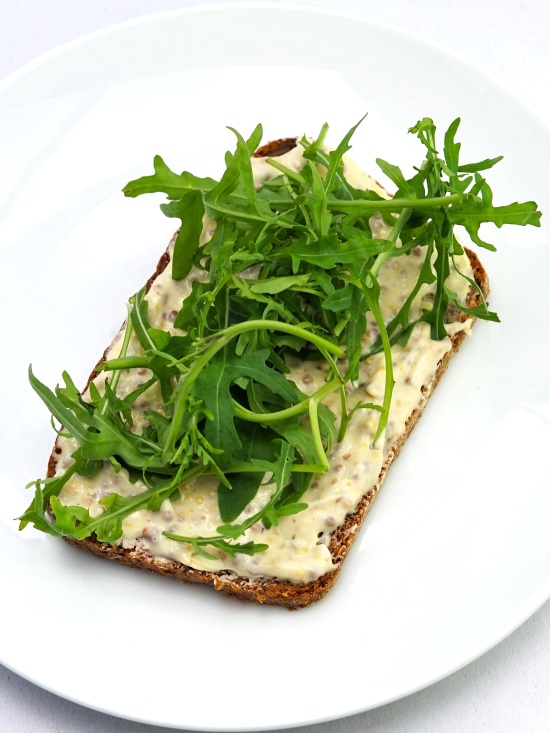
SALAMI OPEN SANDWICH
Here, I’ve spread mustard mayonnaise over the butter. Add whatever type of mustard you like (I’ve used wholegrain) and as much or as little as you want. 1 teaspoon of mustard per tablespoon of mayo is about right for me. Then I added a bed of peppery rocket leaves followed by folded slices of salami. For the garnish there’s quick pickled red onion slices, chopped gherkin and fresh dill.
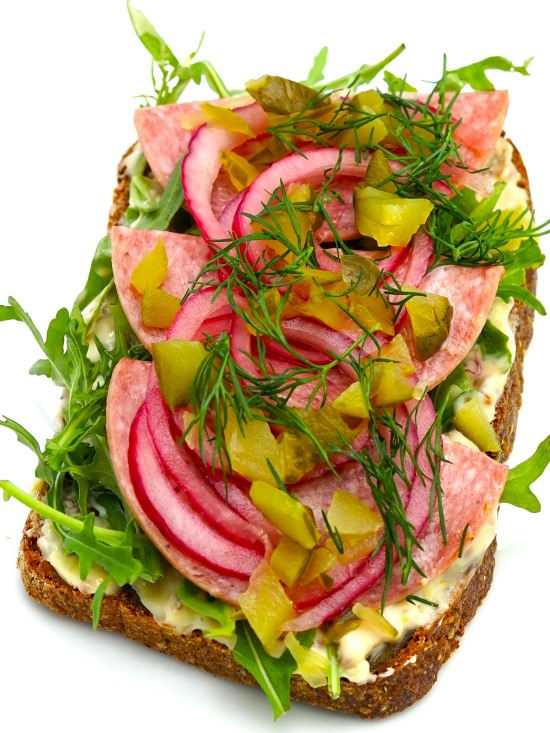
Quick pickled onions (or cucumbers) are a great addition to open sandwiches, bringing a nice acidity. Just combine a mild vinegar like white wine, rice, or cider with half the amount of water. Season to taste with salt, pepper, plus sugar if liked, and add the vegetables. Ready to use in about 30 minutes or leave longer for a stronger pickle. To flavour and store for a couple of weeks see my recipe for Quick Pickled Cucumber.
PRAWN OPEN SANDWICH
A classic sandwich filling or topping are sweet little prawns and I always keep ready cooked cold-water prawns in the freezer. Quick to defrost, they’re perfect for open sandwiches (and, talking of retro, the occasional Prawn Cocktail). Here I’ve kept it simple with a layer of plain mayonnaise over the butter, then lettuce, cucumber, lemon, chives and cress. If you prefer, fold the prawns through more mayo.
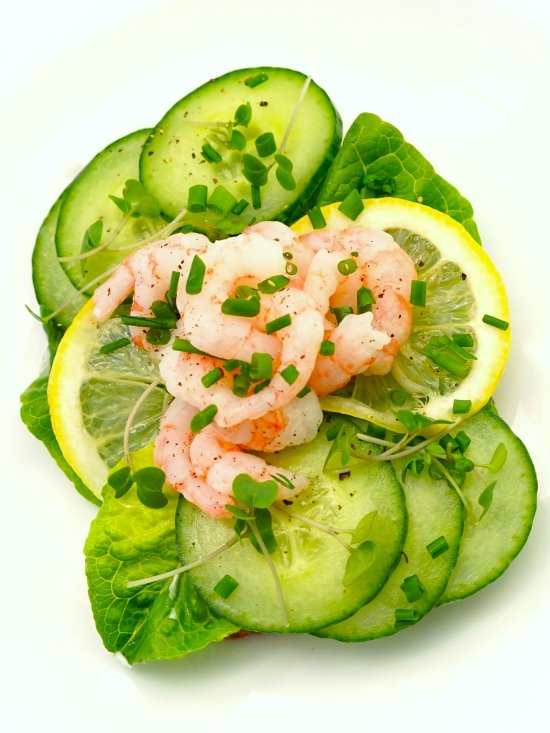
EGG OPEN SANDWICH
This is another very simple one. Plain mayo, lettuce, chives and cress again, but this time with sliced radish, hard-boiled egg, and chopped gherkin. For a little kick of warm heat, I added a sprinkle of Aleppo red pepper flakes.
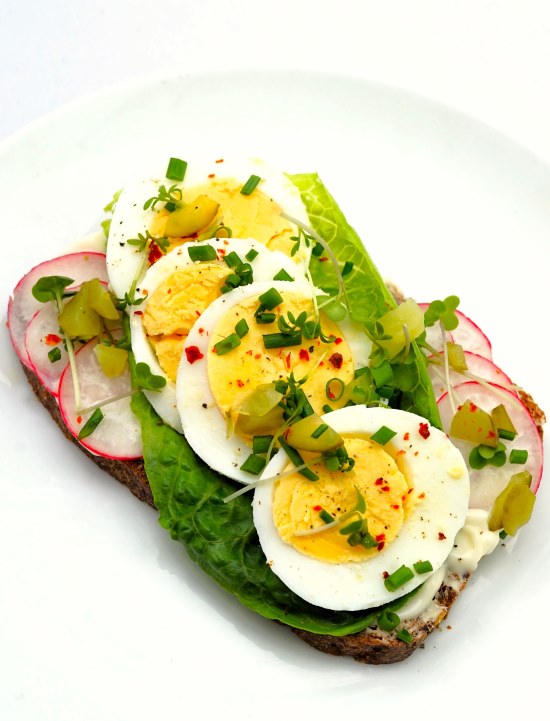
POTATO & BEETROOT OPEN SANDWICH
Although it means doubling up the carbs, there’s something I love about potatoes and bread. Whether it’s a chip butty or, when I travelled in Spain a lot, crusty baguette filled with cold potato tortilla. Here, slices of boiled potato and beetroot sit on a bed of rocket. Beneath is a layer of horseradish flavoured mayo spread over the butter. The garnish is quick pickled onions (made as per the Salami open sandwich above), gherkin and fresh dill.
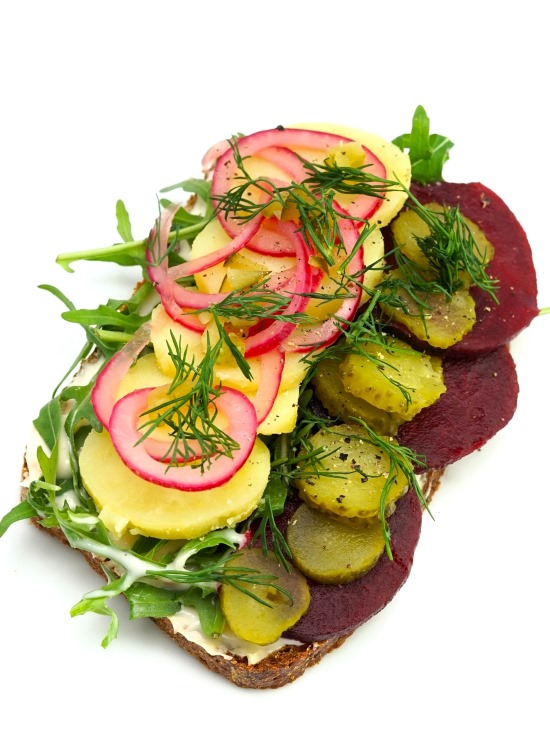
HAM SALAD OPEN SANDWICH
I love a traditional ham salad sandwich. But this Danish-style open sandwich takes it to a whole new level. Over the thickly spread butter goes mustard mayo, rocket, then a generous amount of good quality cooked ham. The garnish is more mustard mayo mixed with lightly cooked then cooled vegetables.
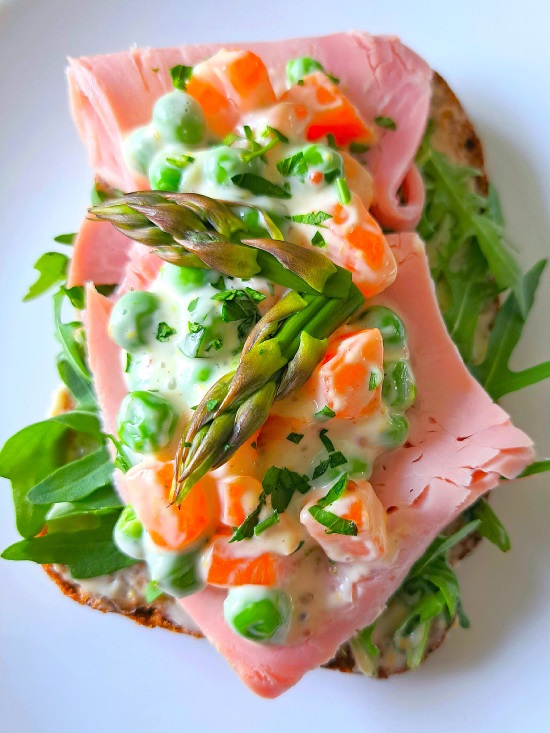
I think this lovely little salad would suit other meat smørrebrød, as well as cheese-based ones. Very the vegetables as you please; I included diced carrot and asparagus, plus peas. On top are raw asparagus tips and a sprinkle of parsley.
GOAT CHEESE & APPLE OPEN SANDWICH
I love the combination of cheese with apple and chose goat cheese for this simple open sandwich. I spread a generous amount of the soft, rindless cheese over the butter then sat sliced apples on top. If not eating straight away, squeeze some lemon over the apples to stop it brown. The finishing garnishes were chopped celery and walnuts plus a few lemon thyme leaves from the garden.
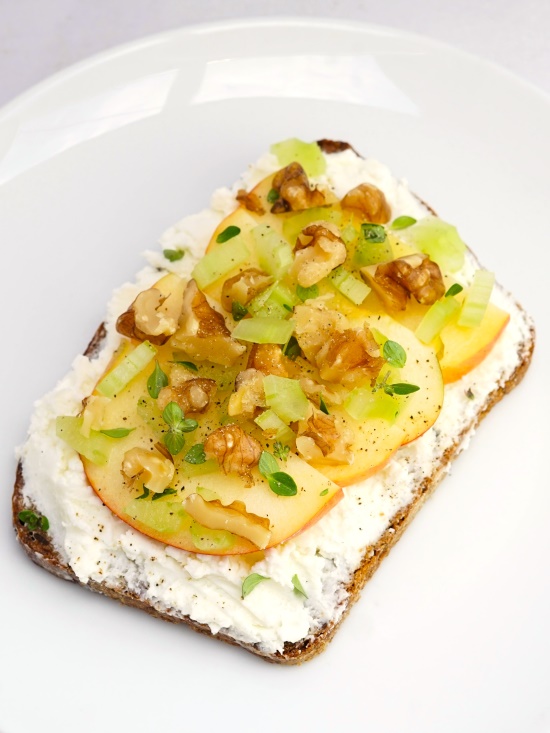
Smørrebrød: GOOD FOR DINNER TOO
Just like on their home turf, in my house smørrebrød is most likely to be eaten at lunchtime. But I think they can be part of a fantastic main course dinner too. And that’s especially true during hot weather. Using foods like smoked fish, cold potatoes or leftover meats, you can get away with very little cooking if you pair some open sandwiches with a big mixed salad.
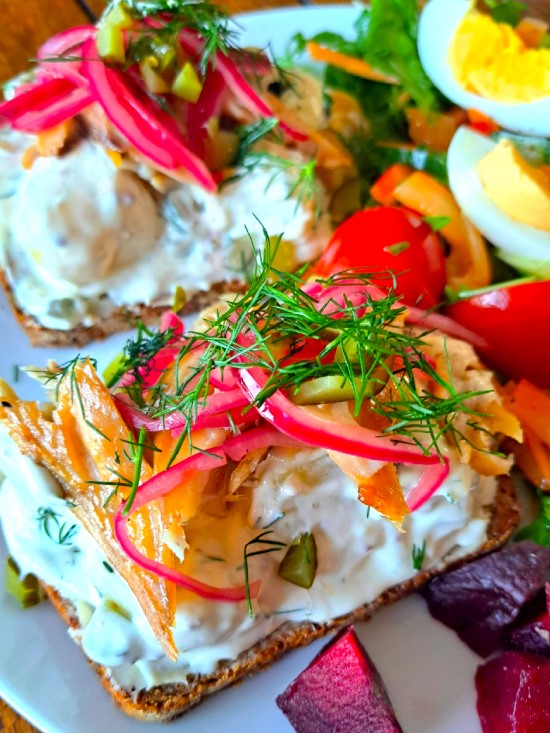
The meal above is a case in point. These open sandwiches I topped with a version of my Potato Salad with Smoked Mackerel with its creamy horseradish and garlic mayo-yogurt dressing. The smoked mackerel that’s usually in the salad went on top, joined by quick pickled red onion and dill. The boiled eggs also normally in with the potatoes I added to the accompanying salad along with lettuce, tomatoes, radish, beetroot, peppers etc.
GREATER THAN THE SUM OF THEIR PARTS
One of the things I love about smørrebrød is that they have the potential to be so much greater than the sum of their parts. Made well and with a generous hand when it comes to the butter, mayo and toppings, even with everyday ingredients an open sandwich can be so good.
For those who want to eat less bread but better bread, their base of thinly cut, nutritious dark rye is ideal. Add to that good quality protein and lots of veggies and you have a real winner. And don’t forget those little garnishes of herbs, spices, chopped pickles, nuts etc. ‘to delight the eye as well as whet the appetite’.
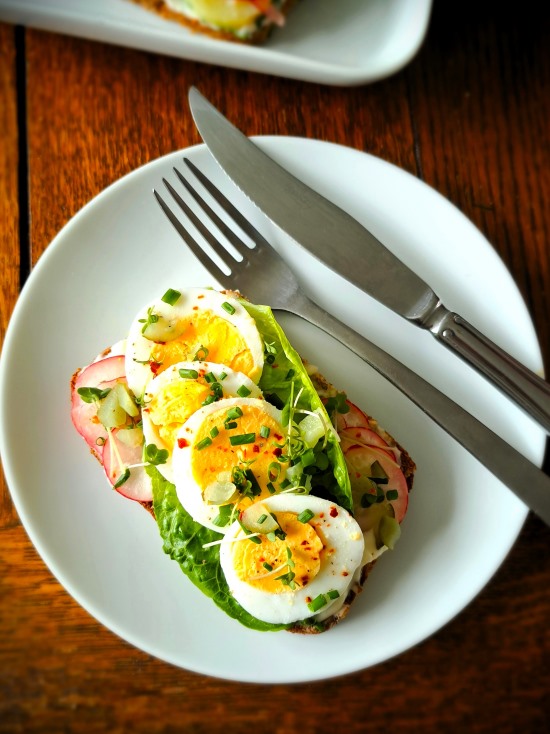
HAVE YOU MADE Smørrebrød? WHICH TOPPINGS DO YOU LIKE? LEAVE A COMMENT & LET ME KNOW.
RELATED RECIPES

